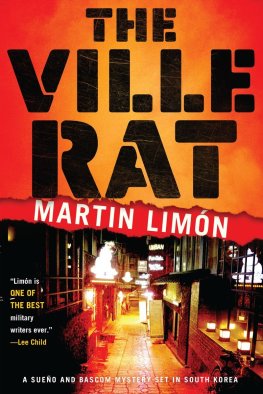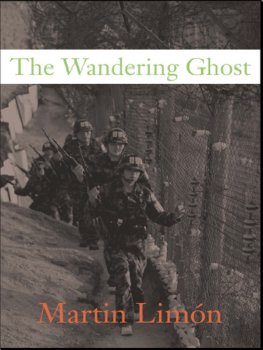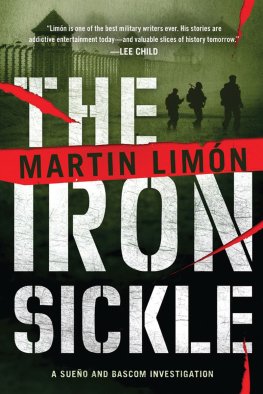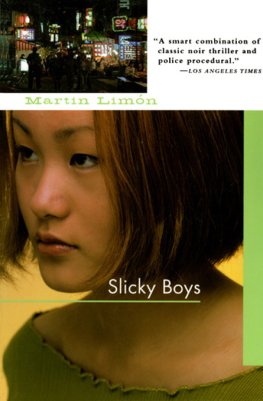Martin Limon - The Ville Rat
Here you can read online Martin Limon - The Ville Rat full text of the book (entire story) in english for free. Download pdf and epub, get meaning, cover and reviews about this ebook. year: 2015, publisher: Soho Press, genre: Detective and thriller. Description of the work, (preface) as well as reviews are available. Best literature library LitArk.com created for fans of good reading and offers a wide selection of genres:
Romance novel
Science fiction
Adventure
Detective
Science
History
Home and family
Prose
Art
Politics
Computer
Non-fiction
Religion
Business
Children
Humor
Choose a favorite category and find really read worthwhile books. Enjoy immersion in the world of imagination, feel the emotions of the characters or learn something new for yourself, make an fascinating discovery.
- Book:The Ville Rat
- Author:
- Publisher:Soho Press
- Genre:
- Year:2015
- Rating:3 / 5
- Favourites:Add to favourites
- Your mark:
- 60
- 1
- 2
- 3
- 4
- 5
The Ville Rat: summary, description and annotation
We offer to read an annotation, description, summary or preface (depends on what the author of the book "The Ville Rat" wrote himself). If you haven't found the necessary information about the book — write in the comments, we will try to find it.
The Ville Rat — read online for free the complete book (whole text) full work
Below is the text of the book, divided by pages. System saving the place of the last page read, allows you to conveniently read the book "The Ville Rat" online for free, without having to search again every time where you left off. Put a bookmark, and you can go to the page where you finished reading at any time.
Font size:
Interval:
Bookmark:
Martin Limon
The Ville Rat
Ville \?vil \ noun: GI slang for village, usually in Asia.
1-
We left the Main Supply Route and turned onto the two-lane blacktop that led toward the village of Sonyu-ri. The road dropped off precipitously and we both held onto the overhead roll bar as the jeep bounced downhill. When we reached ground level, the tire chains caught and began to crunch reassuringly on freshly fallen snow. Still, even though the time was already an hour past dawn, visibility was poor. Ernie switched on the headlights.
Are you sure youre using the right map there, pal?
Official army map, I told him, slapping the folded sheet.
Whats the date on it?
I aimed the beam of my flashlight and checked. Twenty years ago.
Right at the end of the Korean War, Ernie said. This area north of Seoul has changed since then. Half the roads probably arent even listed.
And half the villages, I thought. With two million dead out of a population of twenty million at the end of the war, the Republic of Korea was only now beginning to recover. And they were still nervous about another North Korean invasion. With 700,000 bloodthirsty Communist soldiers on the far side of the Demilitarized Zone, just a few miles from here, who could blame them? On the trip from Seoul, wed passed two ROK Army checkpoints and driven around a mile-long row of armor-blocking cement pilings, and rolled beneath tank traps set to explode if the northern hordes ever decided to come south again.
My name is George Sueno. My partner Ernie Bascom and I are agents for the 8th United States Army Criminal Investigation Division in Seoul. The call had come in at oh-dark-thirty. Our presence was requested at a crime scene some fifteen miles north of the capital city in a village known as Sonyu-ri. Said presence was requested now. Or, as 8th Army liked to say, immediately if not sooner.
We continued to roll down the snow-covered road, passing the Paju-gun County Health Clinic on our right and then a few idle three-wheeled tractors parked along the edge of a four-foot-high berm. Rows of small farmhouses sat cozy in the brisk winter breeze. Fifty yards farther along, just where the map told me they would be, a cluster of blue police sedans waited atop a rise. As we bounced up the dirt pathway, all eyes were on us, even Mr. Kills.
His real name was Gil Kwon-up, chief homicide inspector for the Korean National Police, but Kill is what the American Army MPs had taken to calling him. Changing Gil to Kill made some sort of sense, at least in GI minds. Whenever they could turn a Korean name or word into something American, they did it. Ernie and I had worked with Mr. Kill before, on more than one case, and somehow we had won his grudging respect. Ernie for his ability to blend in with GIs everywhere, under any conditions, and me for my facility with the Korean language and interest in Koreas five-thousand-year-old culture.
Ernie drove up closer to the other vehicles, turned off the engine, and set the emergency brake. We pushed open the stiff canvas doors, climbed out of the jeep, and trudged to the top of the rise.
Mr. Kill wore a broad-brimmed fedora and a dapper overcoat made of thick material. He stood with his hands shoved deep into his pockets, staring at us. He was tall for a Korean but at six-foot-one Ernie loomed over him. I was three inches taller than Ernie, but to show respect for Mr. Kills rank, I stopped lower down on the ridge. We were eye to eye. I nodded a greeting. So did Ernie. Kill pulled his right hand out of his pocket and motioned for us to follow. We did, downhill to the ice-encrusted banks of the Sonyu River.
In the stray beams of a half-dozen flashlights, it was the splash of color I saw first. Bright red. Ernie saw it too. We both stopped. Mr. Kill took two steps forward and then crouched, both to get himself a better view and to give us time to absorb the scene. The rays of illumination coalesced around her, like a spotlight introducing a star. It was then I saw the stiff flesh and the raven black hair.
She was beautiful. Like an ice princess.
Somehow her body had been washed up against the shore and any further drift had been stopped by a foot-high shelf of crystalline white snow. She was wearing a chima-jeogori, a traditional Korean dress made of flowing red silk. The skirt had been tied breast-high, as was the custom, and embroidered with white cranes flapping broad wings to the sky. The short blouse was made of a sturdier material and was canary yellow and tied in the front with a long blue ribbon. Her eyes were open, staring into the opaque grey sky, and the smooth flesh of her face seemed to have been bleached pure white by death. A cold breeze blew down from the north. I shuddered. So did Ernie. So did every cop milling about the crime scene, except for Mr. Kill.
He was known to be impervious to petty feelings. Heartless, some called him. But I knew that when he was on a crime scene he didnt have time for emotions, only thought. And the processes of his mind, coupled with his vast investigative experience, were not good news for the perpetrators of any crime scenes he was assigned to.
I stared at the woman again. Who could have done such a thing? Who could have so cruelly abandoned her in this frigid, unrelenting stream?
The Sonyu River does not run deep. No more than three or four feet now and even less in the dry summer months. But due to the cold snap that had drifted down from Manchuria in recent weeks, it was frozen almost solid, except for the five or six inches of frigid water that rushed by beneath the ice. The river was about twenty feet wide and at its center, for a width of about two yards, it ran quickly and freely.
Ernie looked upstream. How far did she drift? he asked.
Mr. Kill nodded at the question but didnt answer.
Upriver, a basketball-sized chunk of ice broke free and swirled toward the body. It spun madly and crashed into the red skirt, lifting it lewdly up pale legs.
No underwear, Ernie said.
Which was unusual. Part of the traditional female outfit during the winter was a wool tunic and long underpants and warm socks under cotton-stuffed slippers. All designed to combat the long Korean winter. None of these appurtenances were worn by the Lady of the Ice.
The silk string that was used to secure the wrapped skirt was loose, trailing limply in the slow current.
As if we were thinking the same thing, both Ernie and I turned and gazed upriver. The meandering stream ran through rice paddies and past small animal pens and near farmhouses, and although we couldnt see it from here, we both knew that just over the rise was an installation we were both familiar with: Camp Pelham, home of the 2nd of the 17th Field Artillery, which maybe explained why Mr. Kill had called for us. Even though he was the chief homicide investigator of the Korean National Police, under the Status of Forces Agreement signed between the US and the Republic of Korea, he had no jurisdiction on American military compounds.
A large van pulled up and a team of forensic technicians climbed out. They all wore blue smocks and a few of them toted metal briefcases. Stenciled on their backs in block hangul script was the word kyongchal. Police. Mr. Kill left us and gave them a quick briefing. Soon, they were plotting their grids and slipping on knee-high rubber wading boots.
Another group of cops had apparently been canvassing the neighborhood and reported back to Mr. Kill. He listened to them and nodded and then barked further orders, pointing at the homes off in the distance. The men saluted and left.
He walked back to us. Wearily, he nodded toward the corpse. Your thoughts, he said.
I let Ernie go first.
Nobody but a madwoman would leave her house dressed like that, not in this weather.
Font size:
Interval:
Bookmark:
Similar books «The Ville Rat»
Look at similar books to The Ville Rat. We have selected literature similar in name and meaning in the hope of providing readers with more options to find new, interesting, not yet read works.
Discussion, reviews of the book The Ville Rat and just readers' own opinions. Leave your comments, write what you think about the work, its meaning or the main characters. Specify what exactly you liked and what you didn't like, and why you think so.







